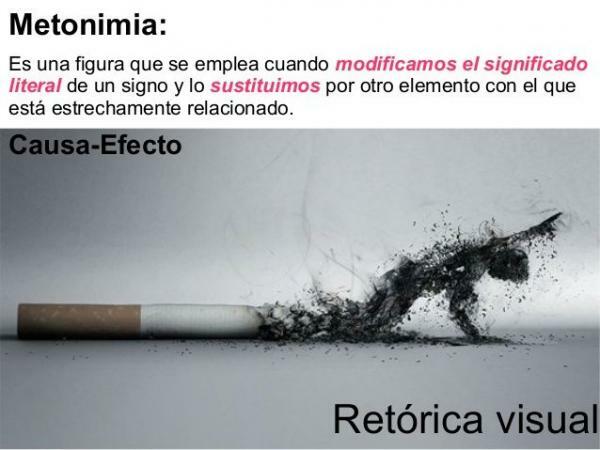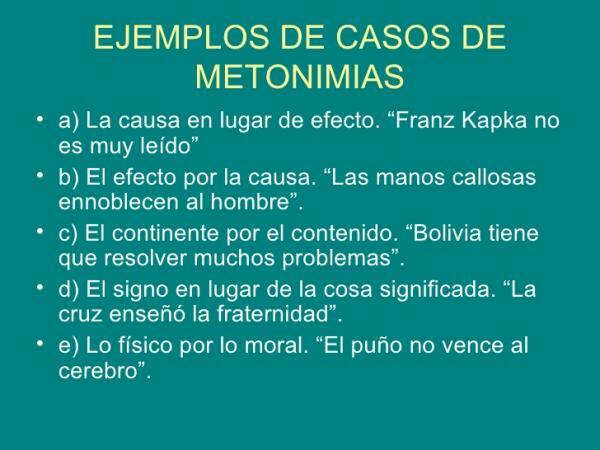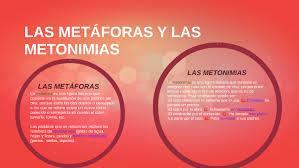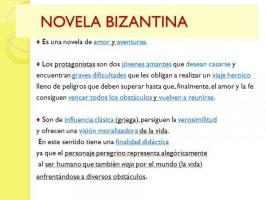Metonymy: examples and definition

Image: Pinterest
Within the literary resources of which our language has, metonymy is one of the most used by both poetry and narrative writers. It is a literary figure that is also widely used in colloquial speech since it has been integrated into our everyday lexicon. In this lesson from a TEACHER we are going to show you some good examples of metonymy as well as a simple definition that will help you better understand this literary resource so common in the Spanish language. Take note of these notes!
The metonymy It's one of the literary resources most used in Spanish and it is about substitute one word for another without affecting the meaning of the sentence. For this change to be feasible it is important that both terms are part of the same semantic field and precisely this is what differentiates metonymy from metaphor (we will analyze this concept later).
Metonymy is also known as transnomination since the name of a designated reality is changed but maintaining the semantic relationship of contiguity. Therefore, metonymy is a resource that requires that there be a contiguity between the two words that they substitute. And this relationship can manifest itself in different ways, so here we discover the different types of metonymy that exist.
Types of metonymy in Spanish
When a speaker uses the resource of metonymy, he knows in advance that the interlocutors will understand the message. The reason is that the meaning to be established between the two nouns must be known for the communication to be effective and not fail. Here we indicate the different types of metonymy that exist so that you better understand what we mean:
- Replace the content with the container: say "I had a mug" instead of saying "I had a beer", for example
- Talk about the instrument instead of the artist: many times, to refer to an artist, the generic word of the instrument is used, such as "the guitar was spectacular", "the bass was apotheostic", etc.
- Go from the concrete to the abstract (or vice versa): You can change words that are more abstract, such as "has a good head" to refer to someone who is intelligent.
- Talk about a place according to what is produced: is when metonymy is used to refer to a space using the name of the object that is produced. For example, "Let's meet at the cafe" to talk about the cafeteria.

Image: SlidePlayer
For you to better understand this literary figure, below we offer you a complete list with examples of metonymy that will help you better detect this resource of our language. Take note of all the examples and put them into practice:
- That Dalí must be very expensive (Dalí = paintings painted by Salvador Dalí)
- I want a Verdejo (Verdejo = wine with DO Verdejo)
- The group's guitar is terrific (Guitar = the artist who plays the guitar)
- He ate the whole plate (Plate = the food that was on the plate)
- I put an end to the conversation (Point and End = I finished the conversation)
- Barcelona is waiting for the expansion of the airport (Barcelona = The province of Barcelona)
- La Moncloa rejected the new laws (La Moncloa = The President of Spain)
- Madrid has knocked down the budgets (Madrid = The government of Spain)
- In the school there was not a soul (Soul = People)
- Put the batteries on now! (Put the batteries = Activate)
- It is one of the indispensable pens of the Golden Age (Pens = Writer)
- Sevilla have won the league this year (Sevilla = Sevilla football team)
- Berlin decided to accept the request of the government of Spain (Berlin = The government of Germany)
- We meet at the cafe at eight (Cafe = cafeteria)
- Spain won against France (Spain's soccer team beat France's team)
- Hit the light (turn the light on)
- Nobody wants another Vietnam (Nobody wants another Vietnam War)
- Nordic beauty is envied all over the world (The beauty of Nordic women)
- Shall we have some beers? (Shall we have a few beers?)
- He sold the Mercedes and bought a Ford (He sold his Mercedes brand car to buy one of the Ford brand)

Image: Examples - Yavendras.com
Surely after having seen all the examples of metonymy that we have indicated, now you have certain doubts about the difference with the metaphor. However, it is important to note that both literary devices are different from each other and have different characteristics.
Essentially, metonymy and metaphor differ because they have different relationships between the words that are replaced. That is, for the metonymy performed optimally it is essential that there is a contiguity relationship between the two elements that are exchanged: the Rioja to talk about the wine that is made in Rioja. That is, there is an intrinsic relationship in both elements and, thanks to this, the interlocutor can understand the message.
Instead, to proceed to use the metaphor, that relationship between the two elements is not objective, that is, it is not real but rather a subjective relationship that the individual does in a totally personal way. Therefore, a metaphor would be "His skin is made of pearls", something that indicates that she has delicate, white and precious skin. At no time is there a real relationship between what is indicated and what is being used to create that image, but there is a dreamlike, subjective and poetic relationship that relates the two concepts.

Image: Prezi



